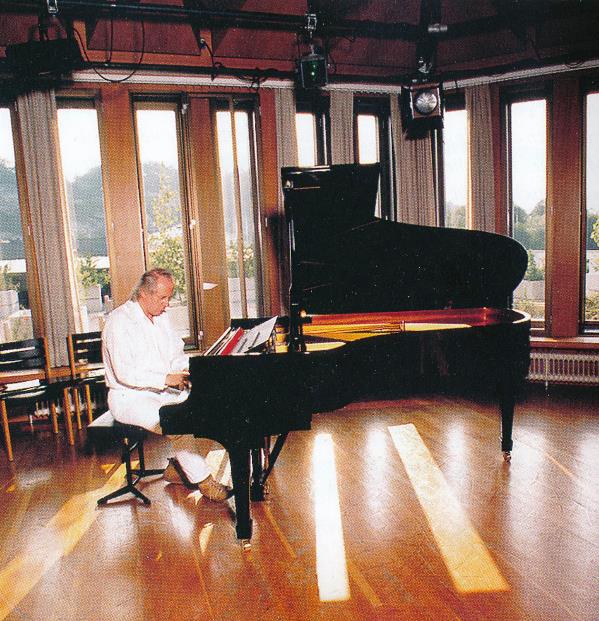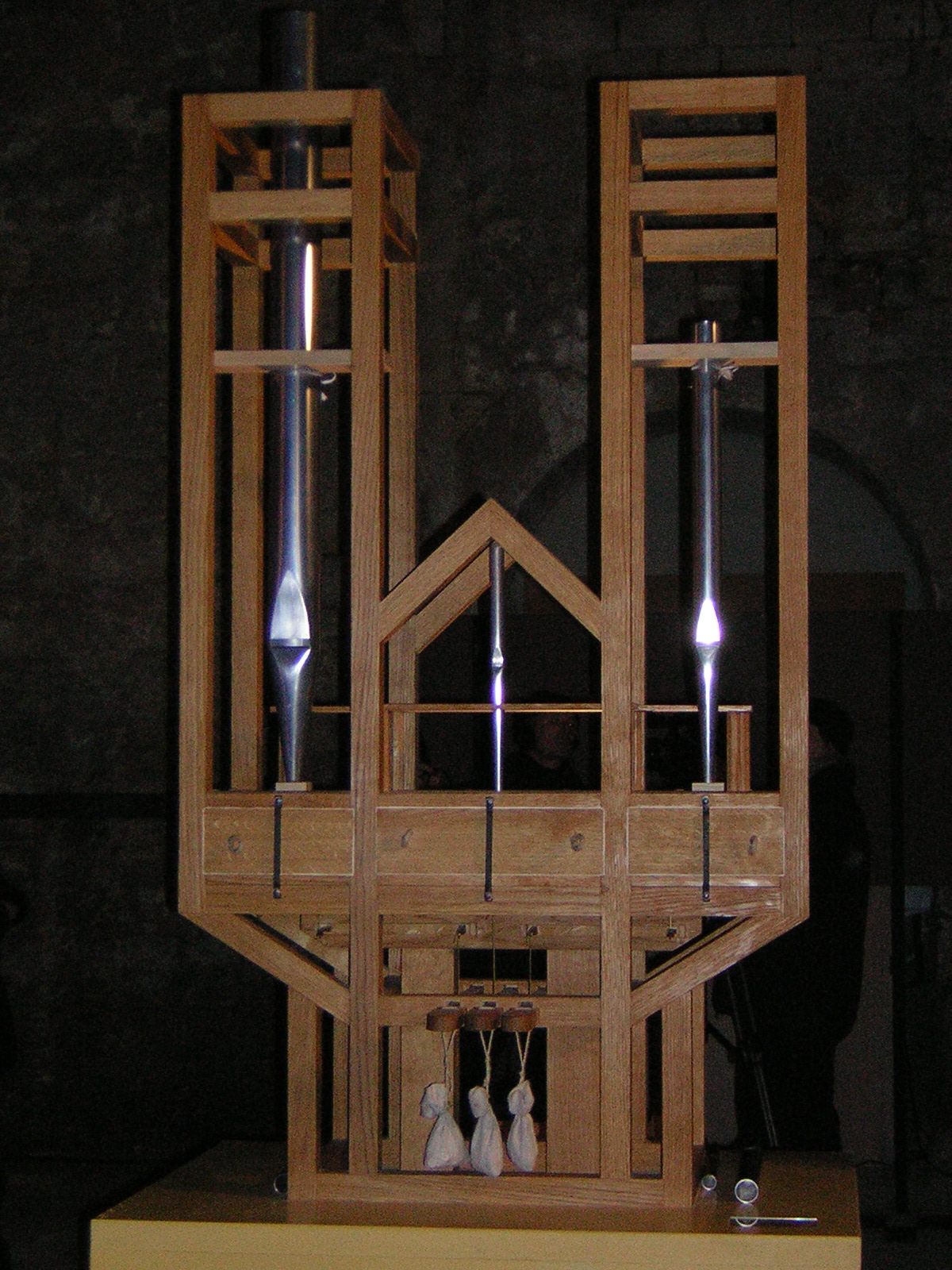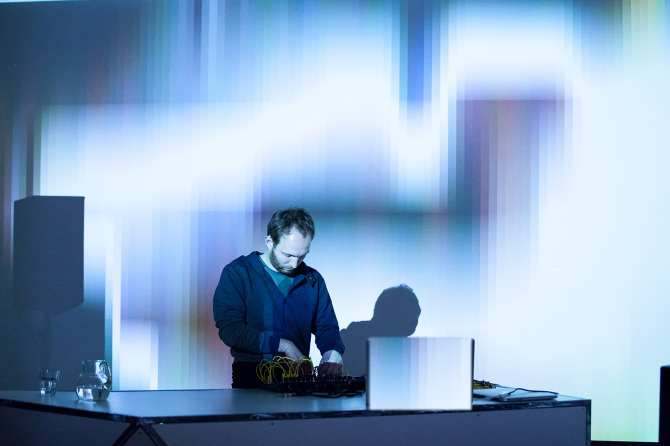I point out a nice blog dedicated to the analysis of Stockhausen’s works:
Category Archives: Contemporary
Anthèmes
Anthèmes refers to two related compositions for violin by French composer Pierre Boulez: Anthèmes I and Anthèmes II.
Anthèmes I is a short piece (c. 9 minutes) for solo violin, commissioned by the 1991 Yehudi Menuhin Violin Competition, and dedicated to Universal Edition’s director Alfred Schlee for his 90th birthday. In 1994, Boulez revised and expanded Anthèmes I into a version for violin and live electronics at IRCAM, resulting in Anthèmes II (c. 18 minutes duration), produced in 1997. (Expansion and revision of earlier works is common in Boulez’s compositional process; see also Structures.)
The title is a hybrid of the French “thèmes” (themes) and the English “anthem”. It is also a play on words with ‘anti-thematicism ‘: “Anthèmes” reunites the “anti” with the “thematic”, and demonstrates Boulez’s re-acceptance of (loose) thematicism following a long period of staunch opposition to it (Goldman 2001, 116–17).
Anthèmes I owes its structure to inspiration Boulez drew from childhood memories of Lent-time Catholic church services, in which the (acrostic) verses of the Jeremiah Lamentations were intoned: Hebrew letters enumerating the verses, and the verses themselves in Latin. Boulez creates two similarly distinct sonic worlds in the work: the Hebrew enumerations become long static or gliding harmonic tones, and the Latin verses become sections that are contrasting action-packed and articulated (though Boulez says that the piece bears no reference to the content of the verses, and takes as its basis solely the idea of two contrasting sonic language-worlds) (Goldman 2001, 119). The piece begins with a seven-tone motive, and trill on the note D: these are the fundamental motives used in its composition. It is also in seven sections: a short introduction, followed by six “verses”, each “verse” preceded by a harmonic-tone “enumeration”. The last section is the longest, culminating in a dialogue between four distinct “characters”, and the piece closes with the two “languages” gradually melding into one as the intervals finally center around the note D and close into a trill, and then a single harmonic. A final “col legno battuto” ends the piece in Boulez’s characteristic witty humour, a gesture of “That’s enough for now! See you later!” (Goldman 2001, 83, 118). [from wikipedia]
See also: Goldman, Jonathan. “Analyzing Pierre Boulez’s Anthèmes: ‘Creating a Labyrinth out of Another Labyrinth’“. Unpublished essay. [Montréal]: Université de Montréal, 2001. OCLC: 48831192.
Andrew Gerzso has for many years been the composer’s chief collaborator on works involving live electronics and the two men regularly discuss their work together. He describes the way in which all the nuances in this nucleus of works were examined in the studio in order to find out which elements could be electronically processed and differentiated. As a result, the process of expanding these works is based not only on abstract structural considerations (such as the questions as to how it may be possible to use electronic procedures to spatialize and to merge or separate specific complexes of sound),but also on concrete considerations bound up with performing practice: in a word, on the way in which the instrument’s technical possibilities may be developed along figurative lines.
IMHO, it is quite clear that the electroacoustic is limited to “dress” the instrumental part, albeit with effects well made. Anthème II is not a real electroacoustic composition and even a revision of the original. But it’s really helpful to students. See also this good page from IRCAM and this one with Max patches.
From You Tube, Anthèmes before and after
Organ2/ASLSP (2015 check)
Sometimes I check if the German site where John Cage’s Organ2 / ASLSP is being performed, expanded to an incredible 639 (six hundred and thirty-nine) years, still exists and the answer so far is yes.
To find out more about this epic execution that began in 2001 and destined to end in 2640, I refer
- to my 2006 post which was the first entry of this blog
- to this wikipedia page dedicated to composition
- to the German site where Organ2 / ASLSP is running
Finally, here you can hear the epic 2006 note change at 8:36 in this audio clip. The last was in 2013 and the next is expected on September 5, 2020.
This is the organ used for execution.
Petite symphonie intuitive pour une paysage de printemps
Luc Ferrari – Petite symphonie intuitive pour une paysage de printemps (1973-74)
A review by Blue Gene Tyranny
A lovely work of electro-acoustic music by one of the French pioneers of musique concrète, “Petite Symphonie Intuitive Pour un Paysage de Printemps” (“Little Intuitive Symphony for a Spring Landscape”) recreates the composer’s experiences during a climb toward sunset on the Causse Méjean, a high plateau in the Massif Central, including his recollection of a shepherd’s flute and its reverberations across the landscape. The flute sounds and multiple echoes continue in changing musical modes throughout the piece (the tonic redefined by electronic drones), blending together with sounds of the countryside and conversational fragments from the human presence to create a beautiful sonic landscape of 25 minutes duration.
Nabaz’mob
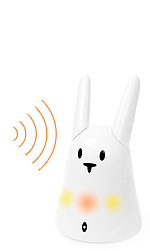
In this post, the story of Nabaztag is taken from Wikipedia, with some notes by myself.
The word Nabaztag (“նապաստակ” which in Armenian language means rabbit) indicates the wifi rabbit conceived by Rafi Haladjian and Olivier Mével and produced in 2005 by the French company Violet.
The object, sold from June 2005, by the end of October 2006 had reached 35,000 copies in France alone. At the end of 2006 a more advanced model was introduced, the Nabaztag: tag that supports mp3 streaming via the internet, has a microphone to receive voice commands and an RFID reader with personalized tags to receive commands. This model also has PULL technology, which means it can query the server on its own initiative. As of September 2007, there are more than 180,000 Nabaztags around the world.
On October 20, 2009, Violet, struggling for insane management, is bought by the well-known software publisher Mindscape which puts on the market an even more advanced model called Karotz with webcam and greater memory capacity. Soon, however, even the latter entered into crisis. On July 29, 2011 Mindscape announced the shutdown of Nabaztag’s management servers, creating 180,000 orphans in one go, but made public the code for managing multimedia “bunnies”, making it possible for different user communities to create new servers. However, the various user communities have favored alternative solutions, based on the Opensource OpenJabNab, Nabizdead and OpenNag projects, simpler to implement than the original server (called “burrow”, referring to wild rabbit burrows) Violet / Mindscape but without support for older first generation Nabaztag units. The user communities born in the immediate closure of the “official” server support only Nabaztag: tags.
Later Mindscape is acquired by Aldebaran Robotics, a company specializing in toy and amateur robots, which sells Karotz’s stocks without developing the product, despite the fact that it had incorporated and clearly visible hooks for accessories and extensions. Finally, with a shocking announcement from its CEO, it communicates the shutdown of the Karotz servers for February 18, 2015, thus marking the end of the project whose existence remains entrusted to amateur servers.
Since the creation of Nabaztag, Antoine Schmitt is its behavioral designer and Jean-Jacques Birgé its sound designer. Together, they also composed the Opera Nabaz’mob for 100 communicating rabbits, which won the Prix Ars Electronica Award of Distinction Digital Musics 2009 and an excerpt of which can be seen in this video.
The video on this page is a shorter excerpt, but the audio is better.
nayral-ro
Un altro lavoro di ::vtol::
The orchestra consists of 12 robotic manipulators of various designs, each of which is equipped with a sound-transmitting speaker. The manipulators, combined together, form a single multi-channel electronic sound orchestra. Due to constant displacement speakers in space, changing direction of the sound and the algorithms for generating compositions, the orchestra creates a dynamic soundscape. In order to interact with the orchestra, controller Leap Motion is used, that allows to control robots and sound by simple hands gestures in the air – similarly to conducting an orchestra.
The project is based on the idea of a combination of modern music, computer, interactive and robotic concepts and approaches for the creation of works of art. In many ways, it is inspired by well-known works that were presented in the recent past, such as Pendulum Choir (2011) and Mendelssohn Effektorium (2013). However, Nayral Ro is different from these projects in many ways. Its algorithmic system, in which sound and musical composition are being produced, is real time, and the acoustic environment also changes simultaneously with the process of creating the musical piece. Also, the whole process is completely subordinated by the “conductor”, so this a role is similar to such of a composer, performer and operator at the same time.
Creation of more sophisticated versions, more subtly revealing the potential of Leap Motion for tuning to the movement and changes in sound, is being planned for the future development.
Metaphase Sound Machine
Questa splendida e inusuale macchina sonora è stata progettata e costruita dal media-artist russo Dmitry Morozov (aka ::vtol::).
The Metaphase Sound Machine is a kind of homage to the ideas of the American physicist Nick Herbert who in the 1970s has created both Metaphase Typewriter and Quantum Metaphone (a speech synthesizer). These were some of the first attempts to put the phenomenon of quantum entanglement in practice and one of the first steps towards the creation of a quantum computer. The experimental devices, however, had not confirmed theoretical research, and Herbert’s obsession with metaphysics resulted in the publication of several of his works on the metaphysical in quantum physics, that have led to a serious loss of interest to the ideas of quantum communication. One day, in a course of his experiments, Herbert has hacked into an university computer trying to establish a contact with the spirit of illusionist Harry Houdini at the day of the centenary of his birth.
In his device Herbert in order to achieve a quantum entangled state used as a source radioactive thallium, which was controlled by the Geiger radiation counter. The time interval between pulses was chosen as conversion code. Several psychics had participated in the experiments. They tried to influence the endless stream of random anagrams arising from a typewriter or cause “the ghost voice” to be heard out of metaphone. Scientists also have conducted sessions to bring about the “spirit” of a colleague who had recently died, and who knew about this typewriter. In 1985 Herbert wrote a book about metaphysical in physics. In general, his invention and articles quite severely compromised the ideas of quantum communication in the eyes of potential researchers and by the end of the XX century no any substantial progress in this direction was observed.
The Metaphase Sound Machine is an object with 6 rotating disks. Each of the discs is equipped with acoustic sound source (a speaker) and a microphone. Each of the microphones is connected via computer and the rotary axis to the speakers on the disks. Also in the center of installation a Geiger-Mueller counter is set, that detects ionizing radiation in the surrounding area. The intervals between these particles influence rotation velocity of each of the disks. Essentially the object is an audio- and kinetic installation in which a sound is synthesized based on feedbacks, produced by microphones and speakers on rotating discs. Feedback whistles are used as triggers for more complex sound synthesis. Additional harmonic signal processing, as well as the volatility of the dynamic system, lead to the endless variations of sound. The form of the object refers to the generally accepted symbolic notation of quantum entanglement as a biphoton – crossing discs of the orbits.
Dmitry Morozov
Treatise da Tempo Reale Electroacoustic Ensemble
Tempo Reale Festival 2012
RUMORE ROSA Il paesaggio delle voci
MUSICA COMUNISTA
Salvatore Miele, coordinamento e live electronics
Francesco Casciaro, oggetti sensibili e live electronics
Daniela Cattivelli, campionatore e live electronics
Andrea Gozzi, chitarra elettrica e live electronics
Damiano Meaccii, regia del suono
Cornelius Cardew
Treatise, per ensemble elettroacustico
(prima esecuzione a Firenze)
Epitaph for Moonlight
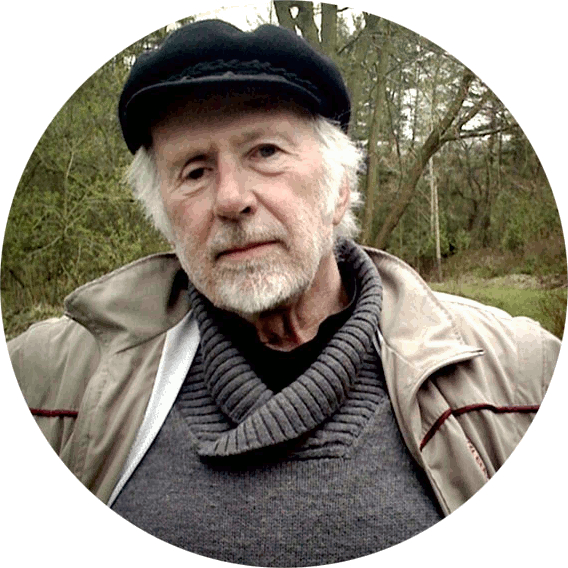 Un altro brano corale di Murray Schafer con una bella partitura grafica.
Un altro brano corale di Murray Schafer con una bella partitura grafica.
Epitaph for Moonlight (1968), for youth choir with optional bells.
Roanoke College Choir, Jeffrey Sandborg director.
It is a free composition in which the singers must improvise from given indications of pitch, intensity and duration. To accompany the voices there is a selection of instruments as desired: glockenspiels, metallophones, vibraphones, triangles, bells, cymbals. The vibrations from these instruments, when used carefully, produced luminous effects that are evocative of moonlight reflecting on water. The score is written graphically and so does not require a knowledge of conventional musical notation.
Snowforms
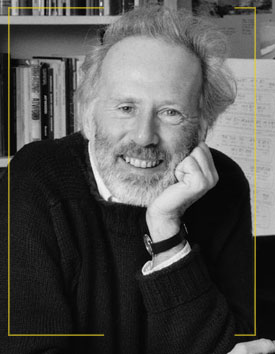 R. Murray Schafer – Snowforms (1982) – for treble choir
R. Murray Schafer – Snowforms (1982) – for treble choir
The text consists of inuit words for various kinds of snow : apingaut , first snowfall; mauyk, soft snow; akelrorak , drifting snow ; pokaktok , snow like salt.
Notes from the composer:
In 1971 I flew the polar route from Europe to Vancouver over Greenland. Clear weather provided an excellent opportunity to study the forms of that spectacular and terrifying geography. Immediately, I had an idea for a symphonic work in which sustained bulks of sound would be fractured by occasional splinters of colour. That experience remains clear in memory. It suggested the orchestral textures of “North/White” and it returns now to shape “Snowforms”, yet very differently, for my memory of the vast foldings of Arctic snow has been modified by the experience of passing winters in Ontario. Often on a winter day I have broken off from other work to study the snow from my farmhouse window, and it is the memory of these forms which has suggested most of the continuous horizon of “Snowforms “.
Sometimes I have given children ‘sight-singing’ exercises in which they are asked to ‘sing’ drawings or the shapes of the distant horizon. Snowforms began as a series of sketches of snowdrifts, seen out the window of my Monteagle Valley farmhouse. I took these sketches and traced a pentagram over them. The notes of the pieced emerged wherever the lines of the sketch and the stave crossed. Of course I modified the drawings as necessary since the work is primarily a piece of music and only secondarily a set of sketches. I printed the work so that the shapes of the snow were in white over a pale blue background.
The entire piece is soft, and I wanted the voices to slide from note to note just like falling or drifting snow. Snowforms is related to Epitaph for Moonlight, Miniwanka and Sun ; they are all descriptions of nature. Later I was to add Fire, A Garden of Bells and Once on a Windy Night as further celebrations of natural phenomena. As the urban populations of the world grow, the forces and charms of nature are more distanced from increasing numbers of people. But I do not write such works out of nostalgia; they are a very real part of my life. Snowforms was actually preceded by a much more complex work of the same name which was performed once by the Vancouver Chamber Choir, but I am glad I withdrew it, substituting this simpler and purer expression of one of nature’s most beautiful elements.
Notes from co-conductors :
This 20 th century monument of treble choral literature was written in 1982 by the imaginative, highly respected, internationally praised composer, R. Murray Schafer. Watching from his farmhouse window in Ontario , Schafer was intrigued by the various shapes, forms, and ever-changing, soft foldings of snow. From these observations came the inspiration to write Snowforms. Using graphic notation, he asks singers to sing ‘shapes’ or ‘drawings’ which are representations of snow forms on the distant horizon. Schafer’s graphic notation is augmented by suggested pitches and the voices are asked to ‘glide’ from one pitch to another in a continuous portamento. A time log is written in the score to suggest durations but Schafer is quite specific that conductors should not feel ‘enslaved’ by the timed suggestions. Although it was written for two part treble chorus, there are a few times within the score when each of the two parts split into four independent lines. Except for the occasional interjection of words which mean various types of ‘snow’ in the Inuit language the entire piece is hummed thereby giving a sense of smoothness and peaceful quietness or hush. Challenges for the conductor are to find gestures that suggest and mirror the contours that are found within the score. Challenges for the singers are to believe the piece will ‘work’ and to trust the instincts and imagination of not only the composer and conductor but also of themselves. Snowforms is a remarkable work that fascinates listeners but more importantly encourages collaboration and exchange of ideas between conductors and singers. It encourages performers to create music beyond the bounds of a traditional score with very satisfying results. – DL

